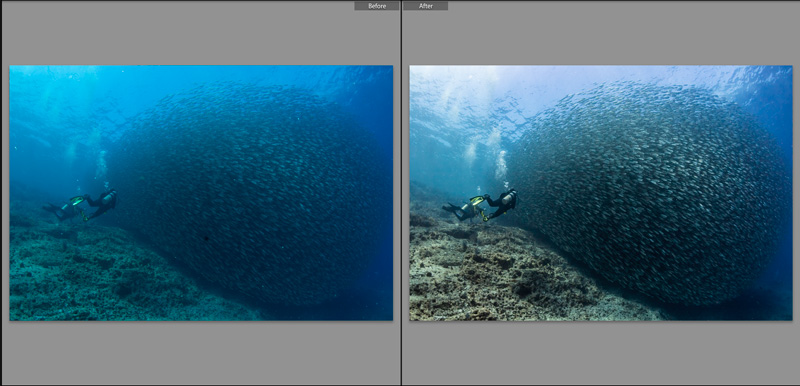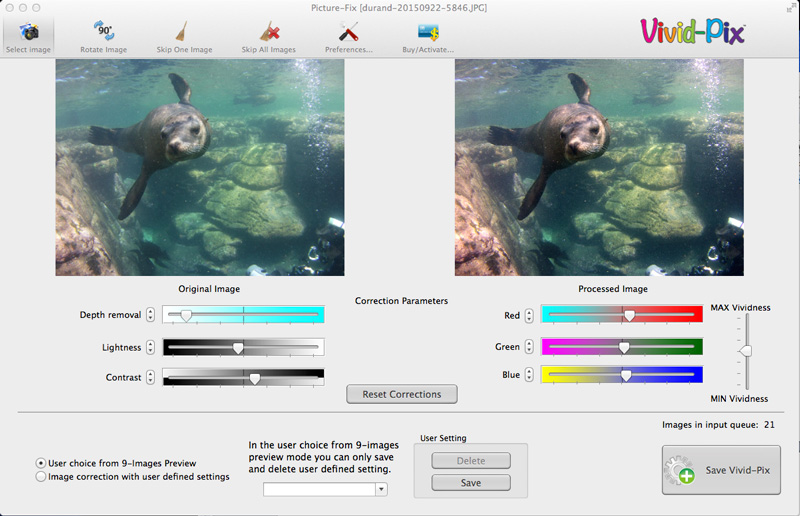
Color filters and post-processing are the subject of many conversations with underwater photographers. Which is better? Does it matter if you use a GoPro or even a DSLR? Can you use a filter and then post-process? Is your photo ruined if you make the wrong choice?
Whoa, that’s a lot, man! In this article we will explore the pros and cons of both underwater color correction methods and the situations when they are best used.
Why do we Need White-Balance Correction?
Water absorbs light as we descend deeper, starting with the red spectrum. This is why everything looks dull green or blue with little contast when diving at deeper depths, and why savvy divers carry a flashlight (torch) to shine on the reef, bringing out the true, vibrant colors. The same principal applies to photographers, who often use a light source to this same thing (via strobes or video lights).
So what about divers who don’t bring artificial light underwater? There are two methods for bringing this color back into the underwater scene and giving your photos some “pop.” The first is to use colored filters over the camera lens. The second is shooting as-is and then adjusting white balance properties while post-processing.
When to Use Color Filters Underwater
Color filters are most commonly used on GoPro cameras, but can also be used with any compact, mirrorless or DSLR setup. The nice thing with filters is that you can pop one on and then magically get great color and contrast. How does it work? The filter (red, magenta, etc) allows the camera’s white balance system to see the reds and chose a much better WB for the photo or video scene.
While underwater filters are great for those who want a quick solution, they are not ideal for all divers. Filters work best when the sun is at your back and when shooting in one direction. Filters also perform best in very specific conditions – certain depths or how blue/green the water is. Because of all these variables, filters doesn’t always make the camera choose the best white balance.
Color Filter Pros
- No post-processing needed for good color
- Easy to pop on and off as needed. Some filter sets even come with several filters for different conditions.
Color Filter Cons
- Because of varying depths, water color and direction to the sun, filters don’t alway make the camera to choose the best white balance for the scene.
Shooting Tip!
Don’t change direction or depth quickly when shooting video with filters, otherwise you will see a dramatic change in white balance as your camera recalculates.
When to Use Color Correction During Post-Processing
Color correction during post-processing can be used anytime your photo looks a bit blue/green or anytime you’re shooting ambient light only (below about 6 feet / 2 meters). All photographers from beginner to pro can make use of this area of post-processing. The beauty is that you don’t need to worry about buying and when to apply different filters underwater – you just go shoot.
Post-processing is viewed as very time intensive, taking as much time as you’re willing to put in to each photo, but the results speak for themselves. The ability to customize the precise color temperature, tint and contrast properties allows you to get the precise color you envision for the photo (note that this works best if shooting in RAW format).
Easy and Quick: This doesn’t have to be time-consuming and difficult. Vivid-Pix makes very easy-to-use underwater photo editing software that literally corrects your photo in one click. You can edit a batch of photos in one click, or dig a bit deeper with customizeable adjustments. Check out our full Vivid-Pix editing tutorial.
Post-Processing Pros
- Customize the precise white balance and color of your images.
- One-click editing software available (Vivid-Pix)
Post-Processing Cons
- One more step between shooing photos and sharing with with your friends, entering into contests like Ocean Art, etc.
Pro Shooting Tip
If you are using a more advanced camera, try setting the white balance manually. Just remember that your custom setting will change as soon as you move direction to the sun or depth. SeaLife cameras have several underwater white balance modes built in.
Which is Better – Filters or Post?
There’s no right and wrong. And just to throw a wrench into the information above, you could use filters AND make some adjustments during post-processing. There are a lot of options out there, so find the method that works best for you.
ADDITIONAL READING













